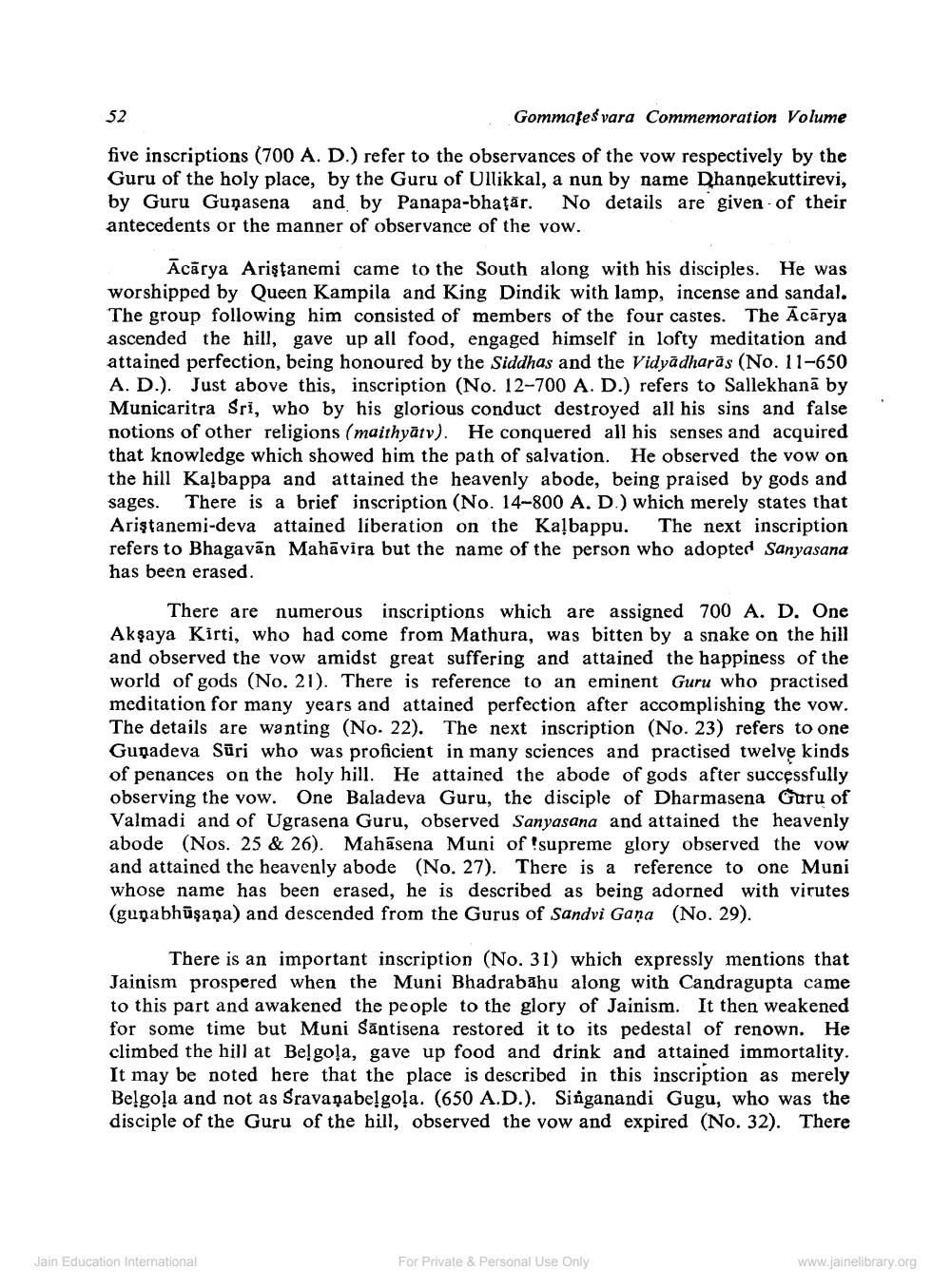________________
52
Gommafes vara Commemoration Volume five inscriptions (700 A. D.) refer to the observances of the vow respectively by the Guru of the holy place, by the Guru of Ullikkal, a nun by name Dhannekuttirevi, by Guru Gunasena and by Panapa-bhatār. No details are given - of their antecedents or the manner of observance of the vow.
Ācārya Ariştanemi came to the South along with his disciples. He was worshipped by Queen Kampila and King Dindik with lamp, incense and sandal. The group following him consisted of members of the four castes. The Ācārya ascended the hill, gave up all food, engaged himself in lofty meditation and attained perfection, being honoured by the Siddhas and the Vidyadharās (No. 11-650 A. D.). Just above this, inscription (No. 12-700 A. D.) refers to Sallekhana by Municaritra Sri, who by his glorious conduct destroyed all his sins and false notions of other religions (maithyātv). He conquered all his senses and acquired that knowledge which showed him the path of salvation. He observed the vow on the hill Kaļbappa and attained the heavenly abode, being praised by gods and sages. There is a brief inscription (No. 14--800 A. D.) which merely states that Ariştanemi-deva attained liberation on the Kalbappu. The next inscription refers to Bhagavān Mahāvira but the name of the person who adopted Sanyasana has been erased.
There are numerous inscriptions which are assigned 700 A. D. One Akşaya Kirti, who had come from Mathura, was bitten by a snake on the hill and observed the vow amidst great suffering and attained the happiness of the world of gods (No. 21). There is reference to an eminent Guru who practised meditation for many years and attained perfection after accomplishing the vow. The details are wanting (No. 22). The next inscription (No. 23) refers to one Gunadeva Sūri who was proficient in many sciences and practised twelve kinds of penances on the holy hill. He attained the abode of gods after successfully observing the vow. One Baladeva Guru, the disciple of Dharmasena Guru of Valmadi and of Ugrasena Guru, observed Sanyasana and attained the heavenly abode (Nos. 25 & 26). Mahasena Muni of !supreme glory observed the vow and attained the heavenly abode (No. 27). There is a reference to one Muni whose name has been erased, he is described as being adorned with virutes (gunabhūşana) and descended from the Gurus of Sandvi Gana (No. 29).
There is an important inscription (No. 31) which expressly mentions that Jainism prospered when the Muni Bhadrabahu along with Candragupta came to this part and awakened the people to the glory of Jainism. It then weakened for some time but Muni Sāntisena restored it to its pedestal of renown. He climbed the hill at Belgoļa, gave up food and drink and attained immortality, It may be noted here that the place is described in this inscription as merely Belgoļa and not as Sravanabelgoļa. (650 A.D.). Singanandi Gugu, who was the disciple of the Guru of the bill, observed the vow and expired (No. 32). There
Jain Education International
For Private & Personal Use Only
www.jainelibrary.org




